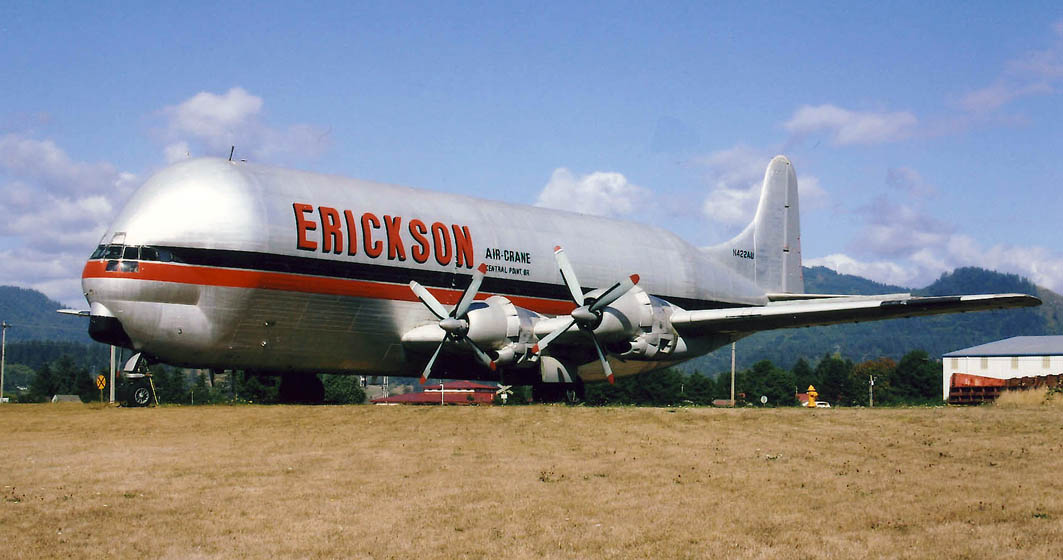
Aero Spacelines Guppy
 |
| N422AU is the only Mini Guppy with the Stratocruiser's original piston engines. It is preserved in Oregon, USA |
| The various types of Guppy produced by Aero
Spacelines Inc stemmed from a need by Nasa to find a quick and simple
way to transport large components for its Apollo moon programme across
the country in the early 1960s.
Coincidentally, many US airlines were retiring their Boeing 377
Stratocruisers at that time and a broker, Leo Mansdorf, was stockpiling
them at Van Nuys in California.
Former USAF pilot John Conroy realised the potential of these aircraft
to transport the large but relatively light rocket components from the
West coast factories to the East coast launch site and approached Nasa
with the idea. One official commented tthat the new type looked like a
pregnant guppy, and that proved to be the name given to the first
aircraft converted. Nasa was lukewarm on the concept by an undaunted Conroy mortgaged his house to form Aero Spacelines Inc to build and operate the aircraft. The Pregnant Guppy was built from a former Pan Am aircraft with a five-metre section of ex-BOAC aircraft added behind the wing. While the rest of the airframe was unchanged, including the four 3,500hp Pratt and Whitney R4360 radial piston engines, a new six-metre diameter fuselage was added above the Stratocruiser's already distinctive double-bubble fuselage. The rear fuselage was completely detachable to allow the rocket sections to be slid straight in. The aircraft flew from Van Nuys on September 19, 1962 and the following summer began flights for Nasa. Interestingly, although the Pregnant Guppy was broken up in 1979, the extreme rear fuselage was used in the contruction of the fourth Super Guppy Turbine for Airbus Industrie, the last Guppy built. As the space programme gathered pace, more aircraft were needed and Aero Spacelines bought 25 more aircraft, including ex-USAF C97s, to build four Super Guppies, although only one was built. It first flew in 1965 and was registered N1038V, as parts of the Pan Am Stratocruiser were used in the conversion, although it was mainly based on a YC97J. The type was powered by four P&W T-34P7 turboprop and flew under contrcat until it was bought by Nasa in 1979. Re-registered N940NA, it was eventually retired and preserved by the Pima Air And Space Museum in Tucson, Arizona. The next development was the Mini Guppy, which dispensed with using various Stratocruiser sections attached together in favour of a totally new fuselage. This allowed a wider fuselage than the earlier models. The type retained the original Wasp major engines but had a swing-tail instead of a detachable unit. The aircraft first flew in 1967 as N1037V and joined the rocket programme until it was sold on to American jet Industries in 1974, then Aero Union, as N422AU, and finally Erickson Air Crane. It is now preserved in Oregon. The next conversion, the Mini Guppy Turbine, first flew in March 1970 powered by Allison 501 turboprops but crashed and was destroyed during a flight test just two months later. Aero Spacelines had more success with its final model, the Super Guppy Turbine. This type also had Allison 501s and first flew in August 1970. ASI had planned to operate the aircraft but got into financial difficulties and sold the two built to Aeromaritime in France for use in the Airbus programme. Two more aircraft followed and the type flew on until the 1990s, collecting wing and fuselage sections from Britain and Germany and taking them to Toulouse for assembly. Three aircraft were preserved on their retirement while one was sold to Nasa in 1997. Re-registered N941NA, it was used to transport International Space Station sections and remains in use. |
| Contents | Photos and census | Update |